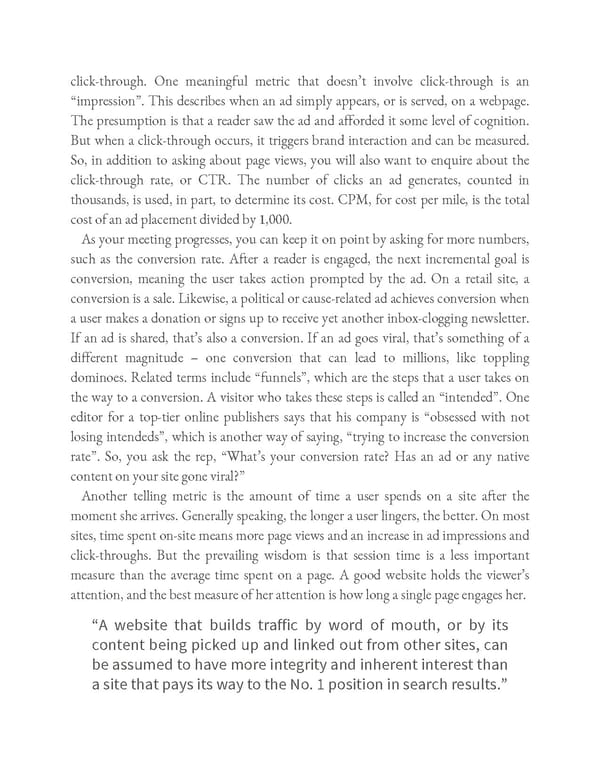click-through. One meaningful metric that doesn’t involve click-through is an “impression”. This describes when an ad simply appears, or is served, on a webpage. The presumption is that a reader saw the ad and afforded it some level of cognition. But when a click-through occurs, it triggers brand interaction and can be measured. So, in addition to asking about page views, you will also want to enquire about the click-through rate, or CTR. The number of clicks an ad generates, counted in thousands, is used, in part, to determine its cost. CPM, for cost per mile, is the total cost of an ad placement divided by 1,000. As your meeting progresses, you can keep it on point by asking for more numbers, such as the conversion rate. After a reader is engaged, the next incremental goal is conversion, meaning the user takes action prompted by the ad. On a retail site, a conversion is a sale. Likewise, a political or cause-related ad achieves conversion when a user makes a donation or signs up to receive yet another inbox-clogging newsletter. If an ad is shared, that’s also a conversion. If an ad goes viral, that’s something of a different magnitude – one conversion that can lead to millions, like toppling dominoes. Related terms include “funnels”, which are the steps that a user takes on the way to a conversion. A visitor who takes these steps is called an “intended”. One editor for a top-tier online publishers says that his company is “obsessed with not losing intendeds”, which is another way of saying, “trying to increase the conversion rate”. So, you ask the rep, “What’s your conversion rate? Has an ad or any native content on your site gone viral?” Another telling metric is the amount of time a user spends on a site after the moment she arrives. Generally speaking, the longer a user lingers, the better. On most sites, time spent on-site means more page views and an increase in ad impressions and click-throughs. But the prevailing wisdom is that session time is a less important measure than the average time spent on a page. A good website holds the viewer’s attention, and the best measure of her attention is how long a single page engages her. “A website that builds traffic by word of mouth, or by its content being picked up and linked out from other sites, can be assumed to have more integrity and inherent interest than a site that pays its way to the No. 1 position in search results.”
 Ogilvy on Advertising in the Digital Age Page 243 Page 245
Ogilvy on Advertising in the Digital Age Page 243 Page 245